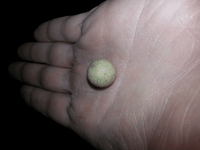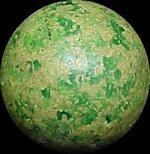Navigation
Install the app
How to install the app on iOS
Follow along with the video below to see how to install our site as a web app on your home screen.
Note: This feature may not be available in some browsers.
More options
You are using an out of date browser. It may not display this or other websites correctly.
You should upgrade or use an alternative browser.
You should upgrade or use an alternative browser.
odd find
- Thread starter Ky Red
- Start date
christo000
Silver Member
- Mar 17, 2013
- 3,765
- 812
- Detector(s) used
- Xp Deus,m-6 pinpointer, technetics t2ltd (had, whites v3i,minelab xterra 705,atpro,prism 4,sunray probe minlabe profind,garret propointer, f75ltd and many more)
- Primary Interest:
- All Treasure Hunting
Ya that's odd any metal in it?
christo000
Silver Member
- Mar 17, 2013
- 3,765
- 812
- Detector(s) used
- Xp Deus,m-6 pinpointer, technetics t2ltd (had, whites v3i,minelab xterra 705,atpro,prism 4,sunray probe minlabe profind,garret propointer, f75ltd and many more)
- Primary Interest:
- All Treasure Hunting
Huh definetly worth getting checked out I think its odd & very cool at the same time,keep me posted if u get it looked at hh
mikecar007
Jr. Member
- Aug 19, 2012
- 76
- 21
- 🏆 Honorable Mentions:
- 1
- Detector(s) used
- Garrett AT Pro
Bounty Hunter Ultra Mag Sharp Shooter
- Primary Interest:
- All Treasure Hunting
I used to have some clay marbles as a kid that were passed down, very cool find
Some marbles can be worth some serious coin.
Diggin-N-Dumps
Gold Member
- Sep 9, 2009
- 6,046
- 3,781
- Detector(s) used
- CTX 3030 / AT PRO / Etrac w/ NEL
- Primary Interest:
- All Treasure Hunting
Great find! I find tons of marbles and stuff digging for coins...never any that old thou.
christo000
Silver Member
- Mar 17, 2013
- 3,765
- 812
- Detector(s) used
- Xp Deus,m-6 pinpointer, technetics t2ltd (had, whites v3i,minelab xterra 705,atpro,prism 4,sunray probe minlabe profind,garret propointer, f75ltd and many more)
- Primary Interest:
- All Treasure Hunting
Dedinetlyvnever seen one myself
surf
Silver Member
- Jan 10, 2013
- 2,832
- 1,458
- Detector(s) used
- seeing eye shovel
- Primary Interest:
- Other
Hello Red,
It's an earthenware marble that has been dyed or painted. I've found jars of them. They're commonly found on 1890-1920 sites.
"EARTHENWARE
Earthenware marbles can be divided into two classes: brown-bodied and white-bodied. The latter class originates from earlier periods than the former. A third class, yellowware, comprises a very small portion of the earthenware marble category.
Common Brown-Bodied Earthenware
Common brown-bodied earthenware marbles are usually referred to as "clays" or "commies." They were manufactured from low-fired brown or red clays, and depending on the amount and type of impurities always present in the clay, would assume a post-firing color of red, brown, gray, or tan. These marbles are very porous and rapidly absorb water placed on them.
These marbles were produced in vast numbers in both Europe (mainly Germany) and America. Their date of production is between the mid 1700s up to the late 1920s or even 1930s. They are often found in their original boxes, most often from Germany but even found in Christensen Agate Company boxes.
Brown-bodied earthenware marbles have been found on archaeological sites dating to the 1600s in England. However, these are isolated incidences and do not represent commercial manufacturing, which appears to have begun until the middle of the following century. By late in the same century they became common enough to be found in significant numbers at archeological sites in Europe as well as America during this period. Early clay marbles were molded by hand, as evidenced by many of them being out-of-round and even having fingerprint impressions, while after the invention of a marble-shaping machine in 1859 they were made more perfectly spherical.
In America, these marbles were probably made locally by immigrant Moravian potters in Bethabara, North Carolina, around 1756-1773. They may also have been produced at potteries in Westmoreland County, Pennsylvania between 1795-1840. In 1889, several potteries in and around Akron, Ohio, began producing "commies." These were apparently made is such mass amounts that the flow of these marbles from Germany was effectively halted.
Many of these American clay marbles were not specifically used in children's games. Large numbers of them were utilized in a number of different manners, particularly in oil cans and oil pipe lines to clean out paraffin buildup.
As mentioned, manufacture of common brown-bodied earthenware marbles began in Akron, Ohio, in 1889. They were first made there by S.C. Dyke and Company, and shortly thereafter by that company's co-owner's brother, Acton L. Dyke. It was Acton Dyke who apparently introduced painted, or dyed, clay marbles in 1890, around the same time he also applied for a patent for machinery that could produce 600 marbles per hour.
The following year the two brothers consolidated their companies and operated as the American Marble and Toy Manufacturing Company until 1904. They soon had their machinery producing approximately 1000 marbles per hour. These marbles were sold both dyed and undyed; the dyed examples were most frequently red, green, yellow, and blue. Some were dyed in solid colors while others were speckled with one or more colors…" Nonglass Handmade Marbles ID
It's an earthenware marble that has been dyed or painted. I've found jars of them. They're commonly found on 1890-1920 sites.
"EARTHENWARE
Earthenware marbles can be divided into two classes: brown-bodied and white-bodied. The latter class originates from earlier periods than the former. A third class, yellowware, comprises a very small portion of the earthenware marble category.
Common Brown-Bodied Earthenware
Common brown-bodied earthenware marbles are usually referred to as "clays" or "commies." They were manufactured from low-fired brown or red clays, and depending on the amount and type of impurities always present in the clay, would assume a post-firing color of red, brown, gray, or tan. These marbles are very porous and rapidly absorb water placed on them.
These marbles were produced in vast numbers in both Europe (mainly Germany) and America. Their date of production is between the mid 1700s up to the late 1920s or even 1930s. They are often found in their original boxes, most often from Germany but even found in Christensen Agate Company boxes.
Brown-bodied earthenware marbles have been found on archaeological sites dating to the 1600s in England. However, these are isolated incidences and do not represent commercial manufacturing, which appears to have begun until the middle of the following century. By late in the same century they became common enough to be found in significant numbers at archeological sites in Europe as well as America during this period. Early clay marbles were molded by hand, as evidenced by many of them being out-of-round and even having fingerprint impressions, while after the invention of a marble-shaping machine in 1859 they were made more perfectly spherical.
In America, these marbles were probably made locally by immigrant Moravian potters in Bethabara, North Carolina, around 1756-1773. They may also have been produced at potteries in Westmoreland County, Pennsylvania between 1795-1840. In 1889, several potteries in and around Akron, Ohio, began producing "commies." These were apparently made is such mass amounts that the flow of these marbles from Germany was effectively halted.
Many of these American clay marbles were not specifically used in children's games. Large numbers of them were utilized in a number of different manners, particularly in oil cans and oil pipe lines to clean out paraffin buildup.
As mentioned, manufacture of common brown-bodied earthenware marbles began in Akron, Ohio, in 1889. They were first made there by S.C. Dyke and Company, and shortly thereafter by that company's co-owner's brother, Acton L. Dyke. It was Acton Dyke who apparently introduced painted, or dyed, clay marbles in 1890, around the same time he also applied for a patent for machinery that could produce 600 marbles per hour.
The following year the two brothers consolidated their companies and operated as the American Marble and Toy Manufacturing Company until 1904. They soon had their machinery producing approximately 1000 marbles per hour. These marbles were sold both dyed and undyed; the dyed examples were most frequently red, green, yellow, and blue. Some were dyed in solid colors while others were speckled with one or more colors…" Nonglass Handmade Marbles ID
Mudflap
Bronze Member
- Mar 31, 2012
- 1,312
- 1,655
- Detector(s) used
- Whites MXT, Dual Field, CZ-21, Vaquero, Home Brewed (3).
Detecting since 1972.
- Primary Interest:
- All Treasure Hunting
I have detected in Westmoreland County, Pa. We used to always find clay marbles around homes.
Top Member Reactions
-
 1898
1898 -
 1043
1043 -
 971
971 -
 969
969 -
 874
874 -
 824
824 -
 769
769 -
 768
768 -
 697
697 -
 585
585 -
 370
370 -
 366
366 -
 352
352 -
 347
347 -
 341
341 -
 337
337 -
E
323
-
 319
319 -
 302
302 -
 278
278
Users who are viewing this thread
Total: 2 (members: 0, guests: 2)







